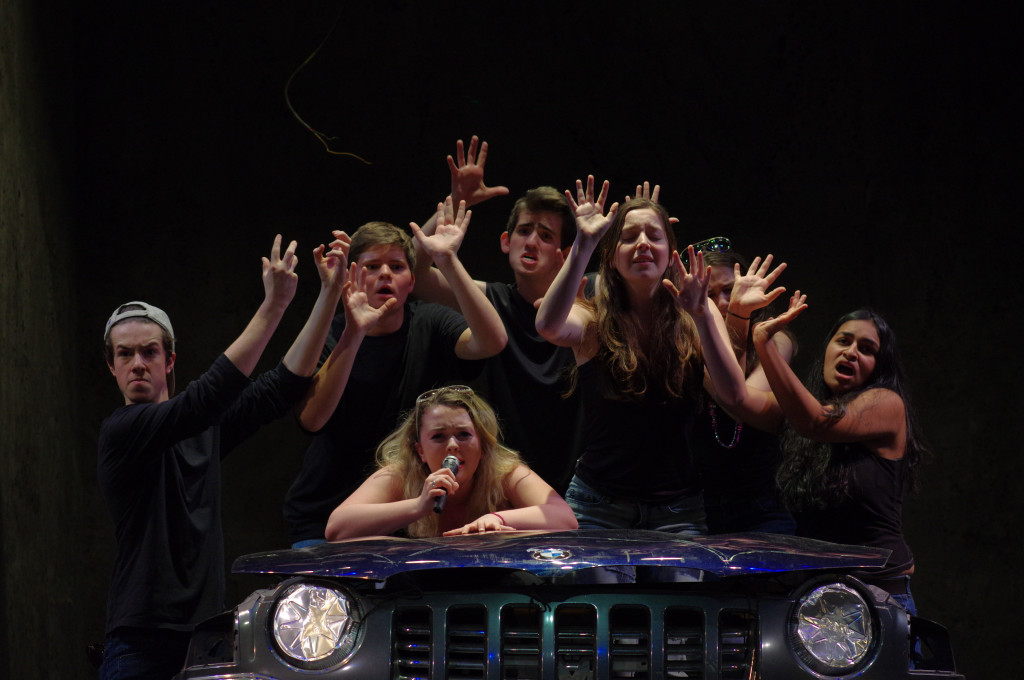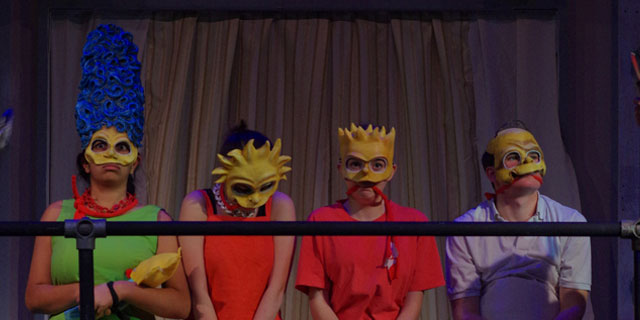
Walking into a theater is like boarding an airplane. You show your ticket, you sit down, and in a few hours, you find yourself in a new and captivating place. The stage functions as an oasis of imagination, the fourth wall as a threshold between impossibility and reality. And yet, even the most wonderful lands of Oz and Camelot often embody issues that pose fundamental human questions. The 2014 Fall Drama, Mr. Burns, a Post-Electric Play, exemplified this intersection of exoticism and relevance in the most profound and artistic way. The production was brave, brilliantly executed, and in the end, indeed flew the audience to a new and captivating place.
Written by Anne Washburn, Mr. Burns, a Post-Electric Play premiered in the spring of 2012 in Washington D.C. and ran again in New York City for about a month in the fall of 2013. The play is comprised of three acts, each of which takes place in a different time period. The first act introduces several of the characters as survivors of a recent cataclysm, the second act takes place seven years later, and the final act takes place 75 years after that. The show plays with the memory and reenactment of television show The Simpsons as an example of popular culture.
“I knew the moment I nestled into my attendance at the original performance that I would do whatever it took to do this play here,” said Clare Mottola, director of the Fall Drama.
Mottola was inspired by the challenges posed by the piece. The demands it puts on the performers, audience, designers, and directors were huge. But ultimately, she said, it was absolutely a worthwhile endeavor.
“The process was totally crazy,” actress Sari Kamp said.
Cast in this challenging production were Babe Howard (VI), Lilly Sterenberg (V), Vedika Gopal (VI), Greg Pizzurro (IV), Eva Neuwirth (VI), Will Conard (VI), Quincy Confoy (V) and Sari Kamp (V).
“There’s a large portion of the process that is simply about building the ensemble and developing a solid foundation for the company,” Mottola said.
The strength of this intimate ensemble was evident in the relaxed and confident presence each actor projected. Mottola’s favorite part of the process when directing a play is “the big ‘aha’ moment when it feels like everyone just ‘gets it.’”
One aspect of this show that set it apart from the majority of Fieldston productions was its overt modernness and representation of contemporary popular culture. The second act, for example, contained a medley of several pop songs, ranging from Beyonce’s “All the Single Ladies” to Katy Perry’s “I Kissed a Girl.”
Assistant director Rachel Serebrenik (V), who was responsible for much of the show’s choreography, described the complexity of weaving modern references into the play while “stay[ing] in the context of the show.” When choosing the medley’s choreography, she explained, the production crew “had to think like the characters in the show and figure out which parts of the music videos they would still remember 7 years in the future.” Serebrenik’s process resulted in tasteful and polished scenes. The inclusion of these contemporary allusions added familiarity, humor, and artistry.
In writing about her piece, Washburn says that the thrust of this play is storytelling, and how storytelling characterizes our existence.
“Our culture,” she writes, “is defined not so much by what has happened to us, but by how we remember it, and the story we create from that memory.”
Her reflection on the play helps explain her choice to have the story take place in three different time periods. She believes that “all storytelling is a remaking of our past in order to create our future.” The progressing time throughout the play and changing of the characters’ lifestyles illuminate this powerful effect of storytelling.
“The message of the show is the vitality of everything going on around us,” Serebrenik said, “and how important it is to shaping the future. It is all about how storytelling is passed through times and how strongly humans hold onto it.”
For Motolla, the post-apocalyptic backdrop played a large role in giving meaning to the show.
“Mr. Burns, a Post-Electric Play is my worst nightmare,” she wrote in the playbill. But the resilience of the characters “has given [her] the lightness to know that although there may be looming darkness ahead, we just may have what it takes to be a little more alright.” The play demonstrates to us, she maintains, that “our tellings, retellings, songs, and scores can inspire and ultimately carry.”
Who knew that The Simpsons could teach us so much? The actors of this production truly brought to life the experience of perseverance and rebuilding, and pushed the audience to consider how memory, narrative, and popular culture shape our understanding of ourselves. Bravo to everyone involved!






